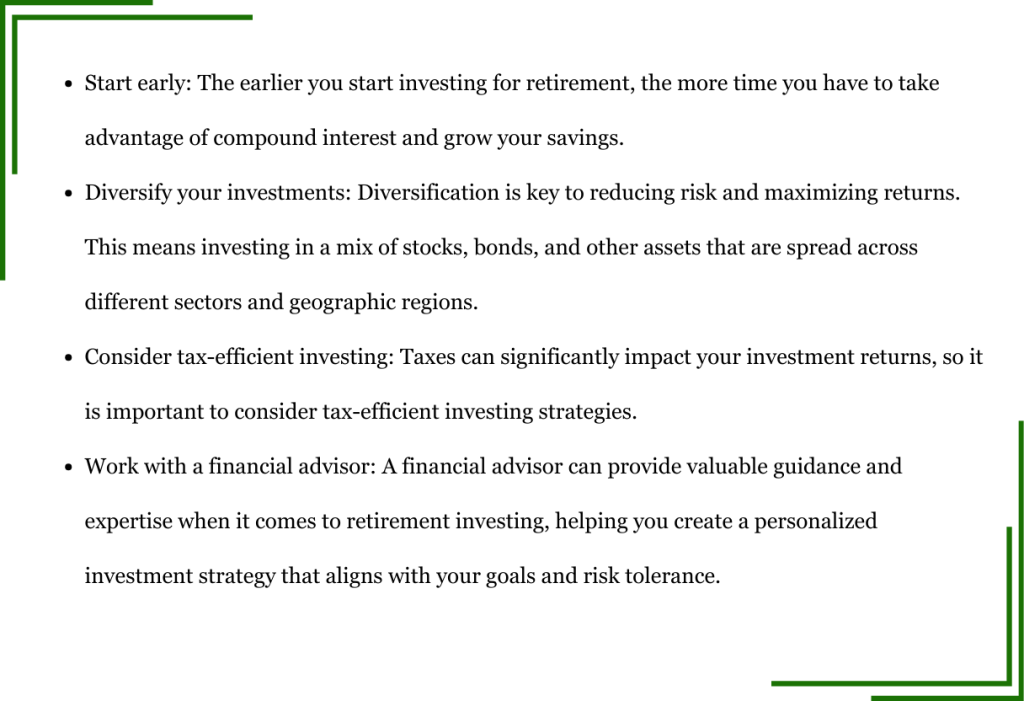Retirement investing refers to investing money to generate income and build wealth for retirement. Retirement investing typically involves setting aside some of your earnings towards a varied collection of stocks, bonds, and additional investments.
The goal of retirement investing is to build a portfolio that can provide a steady income stream during retirement while preserving and growing your savings over time. Retirement investing typically involves a long-term perspective, as it can take several decades to accumulate enough savings to retire comfortably.
Retirement investing can take many forms, including investing in employer-sponsored retirement plans, such as 401(k)s and 403(b)s, individual retirement accounts (IRAs), and taxable investment accounts. Retirement investors may also invest in various assets, including stocks, bonds, mutual funds, exchange-traded funds (ETFs), and real estate.
Retirement investing requires careful planning and consideration, balancing risk and reward, and making decisions that align with your long-term financial goals. Collaborating with a monetary consultant or investment specialist capable of supplying guidance and expertise regarding retirement investing and making it a habit to periodically assess and modify your investment plan to align with any changes in your objectives and situation. over time is essential.
KEY TAKE AWAYS

The Four Retirement Investing Tips from a Financial Advisor
Here are four retirement investing tips from a financial advisor;
1. Start early

Starting early in investing is one of the most important things you can do to set yourself up for long-term financial success. Here are some key takeaways on why starting early is so important:
- Time is on your side: When you start investing early, you have more time to take advantage of compound interest, which is the interest earned on your initial investment and the interest earned on any interest earned over time. The longer your money is invested, the more time it has to grow and compound.
- Smaller contributions can add up: Starting early also means you can make smaller contributions over a more extended period, adding to significant savings over time. Even small contributions made consistently over several decades can grow into a substantial nest egg.
- You can afford to take on more risk: When you start investing early, you have more time to recover from any short-term losses in the market. This means you can afford to take on more risk in your investments, potentially leading to higher returns over the long run.
- You can achieve your financial goals sooner: By starting early and taking advantage of compound interest, you can achieve your financial goals sooner than if you wait until later to begin investing. This can provide greater financial freedom and flexibility in your life.
Overall, starting early in investing is one of the most important things you can do to set yourself up for long-term financial success. By taking advantage of compound interest, making consistent contributions over time, and potentially taking on more risk, you can build a substantial nest egg and achieve your financial goals sooner.
2. Diversify your Investments

Diversifying your investments means spreading your money across different assets, such as stocks, bonds, and other assets, to minimize risk and optimize gains. Here are some key takeaways on why diversifying your investments is essential:
- Reducing risk: Diversifying your investments assists in minimizing the chances of financial loss caused by market fluctuations. Investing in a mix of assets Diversifying your investments can help distribute risk and potentially reduce losses—your exposure to any one investment.
- Maximizing returns: Diversification can also help maximize your diversified portfolio for Strong Returns with different risk and return potential levels. This can help balance out the risks and rewards of your portfolio and potentially lead to higher returns over the long run.
- Providing stability: Diversification can also provide stability in your portfolio by investing in assets that perform differently under different market conditions. This means that even if one asset class is underperforming, other assets in your portfolio may perform well.
- Aligning with your goals: Diversification can also help Ensure that your investment strategy aligns with your objectives and risk tolerance. Investing in a mix of assets that match your goals and risk tolerance can create a personalized investment strategy tailored to your needs.
Diversifying your investments is important because it can help reduce risk, maximize returns, provide stability, and ensure that your investment strategy aligns with your objectives and risk tolerance. Investing in a mix of assets can create a well-balanced portfolio that can help you achieve your long-term financial goals.
3. Consider Tax-Efficient Investing

Tax-efficient investing is investing in reducing charges’ effect on your investment returns. Here are some key takeaways on why tax-efficient investing is essential:
- Maximizing after-tax returns: Tax-efficient investing can help maximize your after-tax returns by minimizing the taxes you pay on your investment income and capital gains. This means you get to keep more investment returns, which can help you reach your financial goals faster.
- Reducing tax liability: Tax-efficient investing can also help lessen your tax liability by investing in tax-advantaged accounts, such as 401(k)s and IRAs, which offer tax benefits such as tax-deferred growth or tax-free withdrawals in retirement.
- Minimizing capital gains taxes: Tax-efficient investing can also help reduce the impact of tariffs by investing in tax-efficient investment vehicles, such as index funds or exchange-traded funds (ETFs), which have lower turnover and generate fewer taxable capital gains.
- Aligning with your goals: Tax-efficient investing can also help align your investment strategy with your objectives and risk tolerance by investing in a way that minimizes taxes without sacrificing your investment goals or risk tolerance.
Overall, tax-efficient investing is important because it can help maximize your after-tax returns, reduce your tax liability, minimize the impact of capital gains taxes, and adjust your investment strategy with your goals and risk tolerance. By investing in a tax-efficient manner, you can keep more of your investment returns and reach your financial goals faster.
4. Work with a Financial Advisor

Working with a financial advisor can yield insightful advice and retirement investing expertise. Here are some key takeaways on why working with a financial advisor is essential:
- Personalized investment strategy: A financial advisor can assist you in developing a customized investing plan that fits your objectives and risk tolerance. They can help you determine the right mix of investments, such as stocks, bonds, and others, to help you reach your monetary objectives.
- Ongoing support and advice: A financial advisor can provide continuing support and guidance as you navigate the ups and downs of the market. They can help you stay on track with your investment strategy and adapt as necessary in light of evolving conditions or aims.
- Tax-efficient investing: A financial advisor can help you invest tax-efficiently, which can help maximize your after-tax returns and minimize your tax liability.
- Retirement planning: A financial advisor can also Adapt as necessary in light of evolving conditions or aims, how to invest your money, and when to begin removing funds from your retirement savings accounts.
Overall, you can benefit from working with a financial advisor. Develop a customized investing plan and offer continuing assistance and advice to help you invest in a tax-efficient manner and plan for retirement. Working with a financial advisor can make you strive for sustained economic prosperity and achieve your goals.
Different Types of Retirement Accounts

Several types of retirement accounts are available to individuals, each with its own set of rules and tax benefits. Here are some of the most common types of retirement accounts:
- 401(k) and 403(b) plans: These employer-sponsored retirement plans allow employees to contribute a portion of their pre-tax income to a retirement account. Employers may also offer matching contributions, which can help employees save more for retirement.
- Traditional IRA: A traditional IRA is an individual retirement account that allows individuals to make tax-deductible contributions, which can help reduce their taxable income. Withdrawals from a traditional IRA are taxed as ordinary income.
- Roth IRA: A Roth IRA is an individual retirement account that allows individuals to make after-tax contributions. Withdrawals from a Roth IRA are tax-free if certain conditions are met.
- SEP IRA: A Simplified Employee Pension (SEP) IRA is a retirement plan for self-employed individuals and small business owners. Contributions to a SEP IRA are tax-deductible, and withdrawals are taxed as ordinary income.
- Solo 401(k): A Solo 401(k) is a retirement plan for self-employed individuals and small business owners. Contributions to a Solo 401(k) are tax-deductible, and the program allows for higher contribution limits than a traditional IRA or a SEP IRA.
- 457(b) plan: A 457(b) plan is a retirement plan for government employees and specific non-profit organizations. Contributions to a 457(b) plan are tax-deferred, meaning they are only taxed once withdrawals are made.
- Thrift Savings Plan (TSP): A TSP is a retirement plan for military personnel and federal employees. Contributions to a TSP are tax-deferred, and the program offers a variety of investment options.
Overall, several types of retirement accounts are available to individuals, each with its own set of rules and tax benefits. By understanding your options and choosing the proper retirement accounts for your needs, you can set yourself up for long-term financial success.
The Compounding Effect of Investment

The compounding effect of investment is a powerful force that can help your assets grow over time. Investing your money earns returns, such as interest, dividends, or capital gains. If you reinvest those returns, they can generate additional returns, which can then be reinvested, and so on. This can lead to exponential growth in your investment over time.
The longer your investment is allowed to compound, the greater the effect. This is because the returns you earn are not only based on your original investment but also on the returns generated by your reinvested earnings. Over time, the compounding effect can lead to significant growth in your investment, even if you are only making small contributions each year.
For example, you invest $10,000 in a mutual fund that generates an average annual return of 8%. After one year, your investment would be worth $10,800. If you reinvested the $800 in earnings into the mutual fund, your investment would be worth $11,664 after two years. After three years, it would be worth $12,597. As you can see, the growth in your investment is based on the original $10,000 investment and the returns generated by your reinvested earnings.
The compounding effect of investment can be a powerful tool for building wealth over time. By reinvesting your earnings and allowing them to generate additional revenues, you can maximize the growth potential of your investments and achieve your long-term financial goals.
The Best Way to Save and Invest If You’re in the Middle of Your Career

If you are in the middle of your career, saving and investing for your future is essential. Here are some tips to help you effectively protect and support during this stage of your life:
- Assess your retirement goals: Determine how much you will need to save based on your retirement goals. This will help you determine how much you must keep each year to reach your goals.
- Increase your retirement contributions.: If you have a 401(k) or other employer-sponsored retirement plan, make the maximum contribution amount allowed. If you are over 50, you can contribute to the catch-up.
- It would be best to diversify your investments: Make sure they are diversified across various asset classes, including bonds, real estate, and stocks. In addition to lowering risk, this may boost returns.
- Consider a Roth IRA: If you are not already contributing to a Roth IRA, consider doing so. Roth IRAs allow tax-free withdrawals in retirement, which can be a valuable source of income.
- Pay off high-interest debt: Paying off high-interest debt, like credit card debt, should be your main priority as soon as possible. This will help reduce your overall debt and free up more money for savings and investments.
- Build an emergency fund: Ensure you have an emergency fund covering at least 3-6 months of living expenses. This can help protect you from unexpected financial setbacks.
- Seek professional advice: To assist you in creating a thorough financial plan that fits your objectives and risk tolerance, think about collaborating with a financial advisor.
Overall, it is important to continue saving and investing for your future during the middle of your career. Following these tips and staying committed to your financial goals can set you up for long-term financial success.
Can You Open Both A Retirement Plan At Work And An Ira?

You can open a retirement plan and an IRA (Individual Retirement Account) at work. Having both types of accounts as part of your retirement savings strategy may be beneficial.
A retirement plan at work, such as a 401(k) or 403(b), allows you to contribute pre-tax dollars to the account, reducing your annual taxable income. Many employers also offer matching contributions, which can help boost your savings. These plans typically have higher contribution limits than IRAs, allowing you to save more for retirement.
On the other hand, an IRA is an individual retirement account that you can open on your own. There are two main types of IRAs: traditional and Roth. A traditional IRA allows you to make tax-deductible contributions, which can help reduce your taxable income for the year. Withdrawals from a traditional IRA are taxed as ordinary income. A Roth IRA, on the other hand, allows you to make after-tax contributions. Withdrawals from a Roth IRA are tax-free if certain conditions are met.
Having both types of accounts can give you more flexibility and diversification in your retirement savings. For example, you can contribute to your employer’s retirement plan up to the match and then contribute additional funds to an IRA. Or, you can contribute to a Roth IRA to take advantage of tax-free withdrawals in retirement.
Overall, a retirement plan at work and an IRA can help you maximize your retirement savings and achieve your long-term financial goals.
Frequently Ask Questions
Here are some frequently asked questions about retirement investing tips from a financial advisor:
Q: When should I start saving for retirement?
A: It’s never too early to start saving for retirement. The earlier you start, the more time your money has to grow. You should start saving for retirement as soon as you start earning income.
Q: How much should I be saving for retirement?
A: The amount you should save for retirement depends on your retirement goals, lifestyle, and other factors. A financial advisor can help determine how much you need to save to achieve your retirement goals.
Q: What types of retirement accounts should I be investing in?
A: The types of retirement accounts you should invest in depend on your situation. A financial advisor can help you determine which accounts best suit your needs.
Q: How can I reduce my taxes on my retirement savings?
A: There are several ways to reduce taxes on your retirement savings, such as contributing to a traditional IRA or 401(k), taking advantage of tax credits, and considering a Roth IRA. A financial advisor can help you develop a tax-efficient retirement savings strategy.
Q: How can I manage risk in my retirement portfolio?
A: Diversification is critical to managing risk in your retirement portfolio. By investing in a mix of asset classes, such as stocks, bonds, and real estate, you can reduce the impact of market volatility on your portfolio. A financial advisor can help you develop a diversified portfolio that aligns with your risk tolerance.
Q: What should I do if I need to catch up on my retirement savings?
A: Taking action immediately is essential to catch up on your retirement savings. Consider increasing your contributions to your retirement accounts, reducing your expenses, and seeking professional advice from a financial advisor.
A financial advisor can provide valuable retirement investing tips and help you develop a comprehensive retirement savings strategy that aligns with your goals and risk tolerance.
Conclusion
In conclusion, retirement investing is a critical aspect of financial planning that requires careful consideration and planning. By starting early, diversifying your portfolio, maximizing your retirement contributions, and seeking professional advice, you can build a solid retirement savings plan that aligns with your goals and risk tolerance. It’s important to remember that retirement investing is a long-term strategy, and it’s essential to stay committed to your plan and adjust it as needed over time.
Working with a financial advisor can be particularly valuable in developing a comprehensive retirement savings strategy. They can provide:
- Practical insights and guidance on managing risk.
- Maximizing returns.
- Achieving your long-term financial goals.
Following these retirement investing tips and seeking professional advice can set you up for a comfortable and secure retirement.

Related Training Program
What is the Wealth Building Way Academy
Learn More about Wealth Building Way here: Click Here Now!
The Wealth Building Way Academy is a Free Video Training
Course Available only to our Readers and Subscribers. Its
A thorough and detailed training available to you. Find
out more about it here. Click and Learn.
Related Articles
- 5 Easy Ways to Increase Your Retirement Income
- THE TECHNICAL TRADERS – RECENT INSIGHTS AND ANALYSIS ROUNDUP
- 4 Retirement Investing Tips for Beginners in 2019
- How To Invest For Retirement?
- 3 Investing Tips and Tricks That Will Totally Pay Off


Dear Trader,
You are invited to test-drive a system that’s quietly produced an astonishing $3.844 Million in real-money profits and an average return of 59.6% per trade while winning 92.0% of all trades
It’s built on a secret trading loophole that has quietly profited $80,809 per month – – proven with account documents.
“When you have Chuck to send you emails and tell you what to do . . . it’s almost too good to be true. Except it is true. And it’s really been pretty amazing. There is no question you can earn significantly more than the way most people trade. I am thrilled. This is fantastic.” – Bill K.
Right now, this options strategy is relatively undiscovered, but . . . some sophisticated investors are starting to take notice.
“Chuck, I’m down here in Florida with my family enjoying our vacation home. I just wanted to thank you for helping me achieve my financial independence! I have gains of $1,430,000 thanks to you! Your recommendations take very little time to execute . . . I’ve been averaging over $29,900 a month in profits over the past three years. Chuck I’m sending a big thank you your way!” – Dan J., Florida
This loophole is revealed here:
Sincerely,

Chuck Hughes
10x Trading Champion
P.S. – Look at what a few others have said…
“I’m getting 203% annual cash payouts using Chuck’s approach. And for me that’s income in excess of $150,000 per year while risking only a small portion of my capital.” – Craig F.
“After 22 years I’ve seen lots of programs come and go. And I truly, honestly believe that Hughes is the best out there, bar none. His methods are very simple. And they work. Even a brand new trader should do well.” — Eric G.
“In about 7 months the account went from $100,000 to $200,000 . . . then it hit $260,000! I mean, it’s just kind of incredible . . . Really!” – Dr. Ted W.

Originally posted 2019-11-22 17:48:02.







